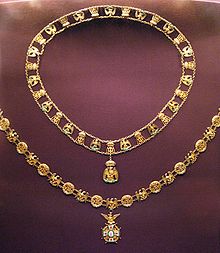- Mexican Imperial Orders
-
There were three Imperial Orders of the Mexican Empire were created to reward those subjects loyal to the Monarchy during the two periods of the Mexican Empire. Those were the Order of Guadalupe, the Order of the Mexican Eagle and the Order of Saint Charles.
All three were abolished after the fall of the Second Empire and the execution of Maximilian I in 1867. Today, the 1917 Constitution of Mexico bans the creation and award of titles of nobility and other hereditary honours in Article 12. Additionally, Article 37 strips of Mexican citizenship those who accept titles that require allegiance to a foreign government or monarch. Foreign awards that do not require allegiance to a foreign government can be accepted after being approved by the Mexican Congress.
Contents
Order of Guadalupe
The Order of Guadalupe (originally: "National Order of Our Lady of Guadalupe") was established by Emperor Agustín I of Mexico in the fall of 1821, although its statutes would not be published until February 1822. It was originally divided in two classes: Grand Cross and Numerary Member. After the death of the Agustin I the Order fell out of use and remained inactive for 30 years until Antonio López de Santa Anna convinced Pope Pius IX to recognize it in 1854. It fell in disuse again in August of that same year after the successful Ayutla Revolution and the ousting of Santa Anna from government.
The third and last period of the Order began on June 30, 1863 before the arrival of Maximilian I by decree of the Provisional Imperial Government. Maximilian I modified the statutes of the Order for the last time on April 10, 1865: he made the order "Imperial" (instead of "National") and divided it in four ranks, each with civilian and military divisions:
- Grand Cross, limited to 30 recipients.
- Grand Officer, limited to 100 recipients.
- Commander, limited to 200 recipients.
- Knight, limited to 500 recipients.
Among those who received this honour were Vicente Guerrero, Alexander von Humboldt and Léopold I of Belgium.
Order of the Mexican Eagle
The Imperial Order of the Mexican Eagle was created by Maximilian I on January 1, 1865. It consisted of two classes: the Superior Class only available to Heads of State awarding a Grand Cross with Collar, and the Ordinary Class consisting of the following ranks:
- Grand Cross
- Grand Officer
- Commander
- Officer
- Knight
The award survives partially (in name at least) in the modern Mexican Order of the Aztec Eagle.
Order of Saint Charles
Not to be confused with Order of St. Charles, established in Monaco, March 15, 1858.The Imperial Order of Saint Charles was created by Maximilian I on April 10, 1866. It was awarded exclusively those women who excelled in the service of their community. The Order honoured Saint Charles Borromeo, Patron Saint of Empress Carlota, sovereign of the Order. It was divided in two classes: the Grand Cross only awarded to 24 Ladies, and the Cross, without any award limit.
Sources
- Royal Ark: Royal and Ruling Houses of Africa, Asia, Oceania and the Americas
- Encuentra.com: The Popes and the Virgin of Guadalupe - in Spanish
- This article draws heavily on the corresponding article in the Spanish-language Wikipedia, which was accessed in the version of August 21, 2005.
See also
External links
State decorations by country Africa FormerAmericas Barbados · Canada (Provinces) · Colombia · Dominican Republic · Jamaica · Mexico · Trinidad and Tobago · United States (Civil · Military · Police)
Asia Burma · Cambodia · Republic of China · Hong Kong · Indonesia · Israel · Japan · Macau · Malaysia · North Korea · Pakistan (Civil · Military) · Philippines · Singapore · Sri Lanka · Thailand
FormerEurope Albania · Armenia · Austria · Belarus · Bosnia and Herzegovina · Bulgaria · Croatia · Czech Republic (Civil · Military) · Estonia · Finland · France · Georgia · Germany (Military) · Italy · Lithuania · Luxembourg · Monaco · Montenegro · Netherlands · Norway · Poland · Portugal · Romania · Russia · Serbia · Slovakia · Slovenia · Spain · Sweden · Turkey · United Kingdom · Vatican
FormerOceania FormerCategories:- Independent Mexico
- Mexican monarchy
- Orders, decorations, and medals of Mexico
- Mexican nobility
- Nobility of the Americas
Wikimedia Foundation. 2010.



